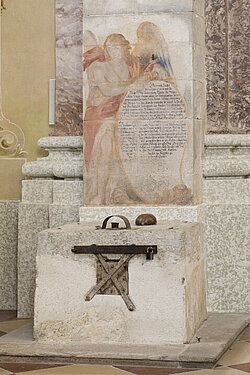Salvation Economics and Media
Constituting Social Spaces via early modern Pilgrimage in Lower Austria (SALVEMED)
As an early modern devotional practice, pilgrimage was deeply shaped by a diverse use of media. In close interplay with the topography and artistic decoration of the pilgrim sites, books of miracles, pamphlets, prints, pilgrimage signs, religious medals and other devotional objects induced intense religious feelings before, during and after the sacred journey. Pilgrimage media inspired people to visit the sacred places, influenced how the sites were experienced and were sought as souvenirs. They also gave the practice of pilgrimage and the religious content a multisensory dimension, and their active-performative reception by the faithful was often associated with an emphasised physical interaction (e. g. by wearing or consuming devotional objects). This interdisciplinary research project, funded by the FWF, employs the analytical lens of ‘condensed mediality’ to examine pilgrimage as a phenomenon manifesting itself in intense communication with a variety of closely interrelated media. Incorporating questions from the fields of (art) history, social and communication studies as well as tourism research, it analyses pilgrimage in Austria below the Enns from its resurgence around the mid-17th century to its (temporary) decline in the context of the Josephine reforms at the end of the 18th century.
The project examines the intricate subject matter on the basis of three case studies of exemplary quality, which are characterised by a favourable source situation, show different types of pilgrimage and can provide overarching insights into the plurality of Baroque pilgrimage in Central Europe through supra-regional contextualisation. One area of focus is the basilica of Sonntagberg, which pertains to the Benedictine abbey of Seitenstetten. This site is regared as one of the most significant pilgrimage destinations in Austria, centered on a place of worship dedicated to the Holy Trinity and the so-called ‘Zeichenstein’. The second object of study is the parish church Maria Hietzing, which was shaped by its proximity to the Viennese court and an urban environment. Housing a miraculous image of the Virgin Mary, the church had a longstanding tradition dating back to the Middle Ages and strong ties to the House of Habsburg. Pilgrimage to the Lower Austrian parish church Pyhra, subordinate to Göttweig Abbey, is explored in a third case study. Here, around the middle of the 18th century, a copperplate engraving after the image of grace at Maria Taferl became itself an object of veneration. The project investigates the ways in which social spaces were constituted through pilgrimage media and the actions associated with them. What were the relationships between these socially defined spaces and how were they integrated into various administrative and economic spheres, as well as structures of rulership?
The project is informed by the methodological considerations of Siegfried J. Schmidt, who described media offerings as products of the interplay of social processes with the help of communication instruments, technical devices and social institutionalisation. The analysis of media that uses a combination of methods (including iconography, narratology, materiality, and history of types) is therefore complemented by an evaluation of the networks involved in their production and distribution, as well as of their various forms of reception. In order to study the practice of piety – characterised by mobility, a high expenditure of time and a clear economic component – approaches from recent tourism research have proven to be extremely fruitful. For example, they allow us to open up the dynamics of media use and structures of perception and behaviour. The concept of the ‘tourist gaze’ – the medially constructed gaze that determines the expectations with which travellers approach certain destinations, how they experience them sensually (through the filter of pre-formed inner images), which places they visit, etc. – can thus be transferred to pre-modern times and interpreted in the sense of a specific ‘pilgrim gaze’. By analysing the economic and social infrastructure of pilgrimages, zones of impact are made visible, previously unnoticed male and female actors emerge from the shadows and unquestioned narratives of research – such as the authoritarian control of pilgrimage – can be scrutinised. The objective is to substantially contribute to a differentiated view of the diverse mechanisms of pilgrimage in eastern Austria and thus of ‘Pietas Austriaca’ by investigating the role of media and the associated socio-spatial networks.
Contact and project leader
Univ.-Doz. Dr. Werner Telesko, w. M.
Project staff
Mag. Dr. Veronika Decker
Mag. Dr. Thomas Kühtreiber
Mag. Dr. Sabine Miesgang, M. A.
Sarah Deichstetter, BA BA MA (Doktorandin)
Associated research institution
Cooperation partners
Stift Göttweig
Mag. Bernhard Rameder, Custodian of the Collections
Mag. Dr. Angelika Kölbl, Archivist
Stift Klosterneuburg
Mag. Dr. Martin Haltrich, Director of the Research Center (FoKuS)
Project duration
October 2024 – September 2027
Funding
Austrian Science Fund (FWF)
Projektnummer PAT 1390723





